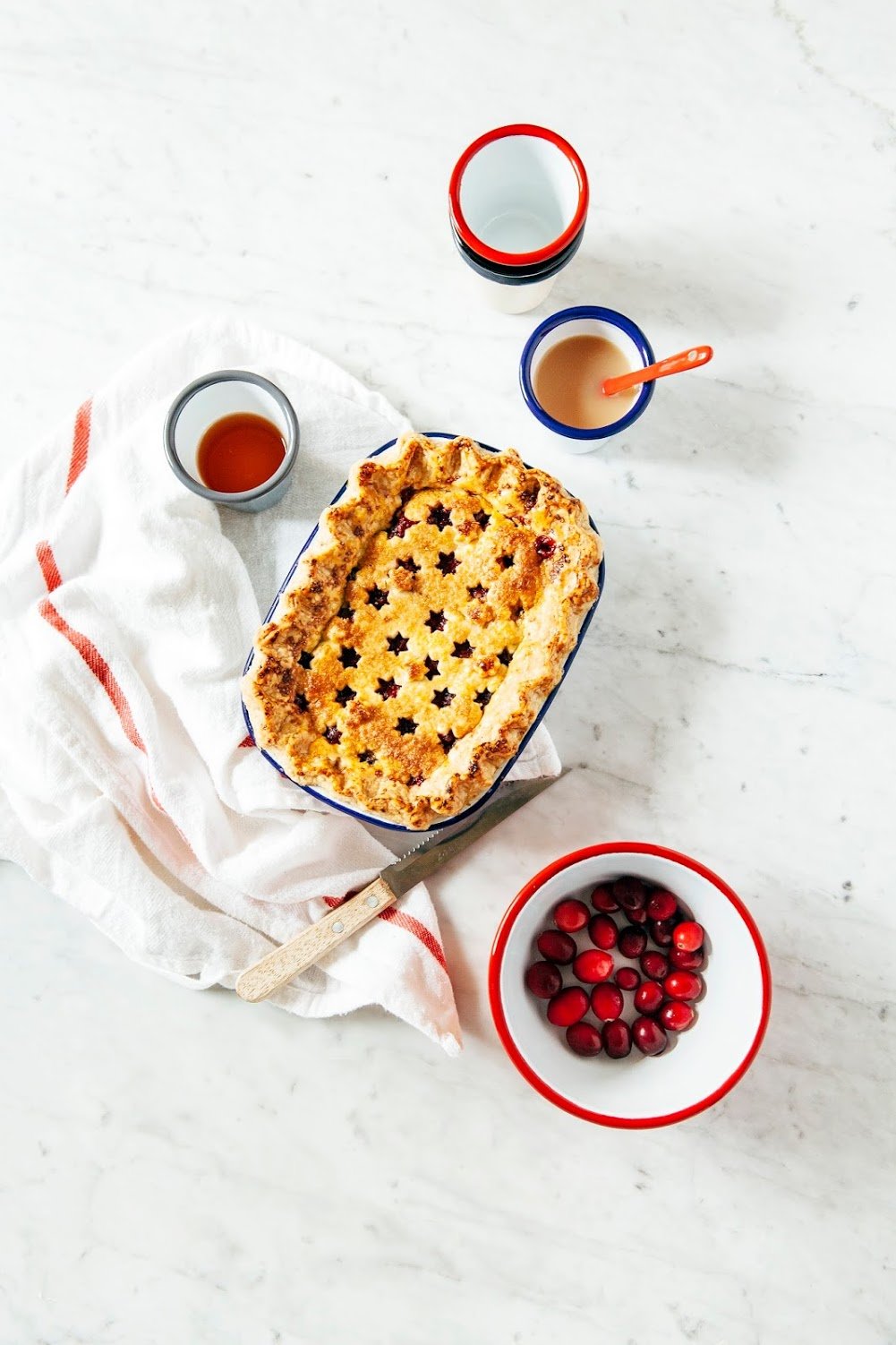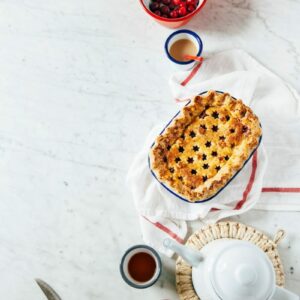Every time I make a pie, it feels like a freaking marathon: the constant rolling and re-rolling of the dough, the chilling and re-chilling of the pie, the crimping, the latticing, the filling. And I don’t even rest easy after the pie has been transferred to the oven; instead, I spend almost the entire hour crouched by the oven window, coordinating my Spotify to the pie’s progress (a crust that loses its shape and melts slowly away usually gets a soundtrack of Bon Iver), all the while texting friends and tweeting panicked updates. Because after all that work, I don’t even know if my pie will turn out well — I’ve talked about this before, but I’ve never been the world’s best pie maker. Despite my best efforts, my pies never turn out as pretty as the ones I see on Pinterest.
Until now.
There’s a myth out there that the best pie crusts are all-butter. It’s perpetuated by big food blogs like Food52 and established culinary experts like Serious Eats. An all-butter crust is a right of passage—no, a medal—for people and a chance to brag about bullshit like how their naturally cold hands helps them shape the finnicky dough easily. Right. Whatever.
And for a long time, I bought into that myth. Every recipe I ever tried was made with butter, and butter only. Artificial and highly processed fats like shortening and margarine were out of the question ‘cuz… well, gross.
But what about lard? Lard is also kinda gross if you think about it too much; I mean, after all, it is just PORK FAT. But at least it isn’t as highly processed as shortening and margarine? And although animal fat kinda gets a bad rap in general, more and more studies are showing that it’s actually beneficial for the body to consume a moderate amount of animal fats on occasion.
I don’t know what compelled me to finally try using lard in my pie crust, but I’m glad I did. Every lard crust I’ve made has been incredibly flaky and tender — I actually prefer its flavor and texture than that of an all-butter crust. But what’s best about a lard crust is that it’s forgiving. Unlike all-butter crusts, it’s less sticky, more malleable, and perhaps most importantly, almost always holds its shape when baking in the oven.
So with the help of pork fat (of all things!), I might have just conquered the picture perfect pie. Watch out, Pinterest! Me and my lard crust — we’re coming for you. No, really. One of my resolutions this year was to bake more pie. I’m aiming for one pie a month. Is that too ambitious? I don’t know. We’ll find out. Watch this space.
Thank you to Falcon Enamelware for sponsoring this post by providing all the pretty pie plates, tumblers, and prep bowls that you see in the photos. I’m especially excited to work with them as I’ve spent many years lusting after their products at Schoolhouse Electric. These pictures were featured in their December newsletter, which you can sign up for on their site or check out on their Tumblr. As always, all thoughts and opinions are my own, and thank you for supporting Hummingbird High and my sponsors!
Some baker’s notes:
-
- I know lard sounds really grim and gross, but I promise you that if you go with a good quality one, it won’t be. First, you want a rendered lard — that means that excess water and other impurities have been taken out of the raw fat, leaving you with a shelf stable, white-ish, creamy fat. You’ll also likely want leaf lard, which is from the kidney region of the pigs and doesn’t have as many vessels or meat in it. It’s especially creamy and soft and perfect for pies. I like using Fatworks’ Leaf Lard, which I know is pricey, but is really worth the quality since it comes from pigs that are free-range and pasture raised by small, family-owned farms.
-
- We’re at that terrible part of winter where no fruit is really in season except for citrus and cranberries; hence the cranberry filling for the pie. I like my pie fillings to taste like fruit, so the filling tastes exactly like cranberries — not that sweet and pretty tart. It works wonderfully with the crust (and together kind of taste like those shortbread cookies with jam in the middle, a.k.a. DELICIOUS), but on its own, can be kind of intense. So taste the filling as you go, and after cooking the cranberries, feel free to add extra sugar to the filling (I recommend going up to 1/4 cup extra) if you find it too sour for your taste. Alternatively, you can also just leave the recipe as is and serve it with ice cream or whipped cream!
- To stamp out the stars in the top crust, I used a mini star cookie cutter from this mini cookie cutter set, but Amazon has a wide variety of shapes that you can choose from. But you can also go the traditional route and just create a classic lattice top — you can do whatever you like! However, just because this crust is partially made out of lard, doesn’t mean that the usual rules don’t apply. In order to keep your crust looking the same way as it did before baking, make sure you keep all the ingredients and crust as refrigerated as possible. Be sure to check out all my best pie baking tips!
Get the Recipe: Sour Cranberry Pie
Ingredients
For the Lard and Butter Crust
(makes 2 small rectangular pies, or a 9-inch double crust pie)
- 1 cup (8 ounces) ice
- 1 cup (8 ounces) cold water
- 1/4 cup (2 fl. ounces) apple cider vinegar
- 2 1/2 cups (12.5 ounces) all-purpose flour
- 1 tablespoon granulated granulated sugar
- 1 teaspoon kosher salt
- 1/2 cup (1 stick // 4 ounces) cold unsalted butter, cut into ½-inch pieces
- 1/2 cup (4 ounces) cold lard, cut into ½-inch pieces
For the Sour Cranberry Filling
(enough for 2 small rectangular pies, or a 9-inch 1 double crust pie)
- 1/2 cup (3.5 ounces) granulated sugar
- fresh zest from 1 medium orange
- 3 1/2 cups (4 pounds) fresh or frozen cranberries
- 1/4 cup (1.5 ounces) dark brown sugar, tightly packed
- 1 vanilla bean pod
- 1/4 cup (4 ounces) cornstarch
For the Pie
(enough for 2 small rectangular pies, or a 9-inch 1 double crust pie)
- 1 tablespoon all-purpose flour
- 1 tablespoon granulated sugar
- 1 large egg yolk, gently whisked
- demerara (or other coarse) sugar, for sprinkling
Instructions
For the Lard and Butter Crust
- Combine 1 cup ice, 1 cup cold water, and 1/4 cup apple cider vinegar in a liquid measuring cup and whisk. Transfer to the refrigerator to keep chilled as you prepare the dry ingredients.
- In a medium bowl, whisk together 2 1/2 cups all-purpose flour, 1 tablespoon granulated sugar, and 1 teaspoon. Add 1/2 cup unsalted butter and 1/2 cup lard pieces, and toss to over with the flour mixture. Use a pastry cutter to cut the butter and lard pieces into the flour mixture, working quickly until mostly pea-sized pieces of the fat remain.
- Remove the ice water mixture (from the 1st step) from the refrigerator and sprinkle 2 tablespoons of the ice water over the flour mixture, and use the pastry cutter to cut the water into the flour until it is fully incorporated. Add more of the ice mixture a couple tablespoons at a time, and continue mixing until the dough comes together in a ball. Divide the ball into two even halves; shape each half into a flat disc. Wrap each disc in plastic, and refrigerate for 1 hour, preferably overnight.
For the Sour Cranberry Orange Filling
- In a medium bowl, combine 1/2 cup granulated sugar and fresh orange zest from 1 medium orange. Use your fingers to rub the zest into the sugar until the zest is fully coated in sugar and the sugar becomes fragrant. Set aside.
- In a large, heavy-bottomed pan, combine 3 1/2 cups cranberries and 1/4 cup dark brown sugar. Split the vanilla bean pod lengthwise and use the tip of a sharp knife to scrape the vanilla beans from the pod and into the pot containing the fruit and sugar. Add the vanilla bean pod, and cook the mixture over medium heat, stirring frequently until the cranberries have released their juices, thickening and darkening in color, around 15 minutes.
- Fish out the vanilla bean pod and transfer the cranberries to a large bowl and immediately whisk in the granulated sugar and orange zest mixture (from the 1st step), followed by 1/4 cup cornstarch. Continue whisking until both are full incorporated into the mixture. Set aside on a wire rack to cool to room temperature.
To Bake the Pie
- Whisk together 1 tablespoon all-purpose flour and 1 tablespoon granulated sugar in a small bowl. Before transferring the filling into the pie dough, sprinkle the base of the pie with the flour and sugar mixture. Scoop the cranberry filling over the mixture, and then proceed to cover the filling with the pie’s top crust. Refrigerate for 1 hour.
- After the pie has been chilled, center a rack in the oven and preheat to 350 (F).
- Once the oven is preheated and you’re ready to bake the pie, use a pastry brush to brush the egg yolk over the sides and top of the pie crust, before sprinkling with a generous amount of demerara sugar.
- Bake in the preheated oven for 1 hour, or until the fruit filling starts to bubble and the crust has browned. If the edges of the pie start to brown faster than the center, cover the edges with aluminum foil.
- When the pie is finished baking, transfer to a wire rack and allow to cool for 1 hour to let the filling set before serving. Serve warm, with a scoop of ice cream or lightly sweetened whipped cream to offset the tartness.









